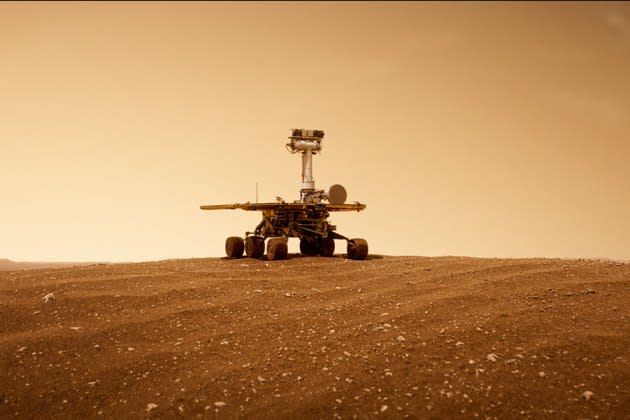‘Good Night Oppy’ Director Ryan White Talks NASA, Robots and Mars

The day before the pandemic shut down Los Angeles in March 2020, veteran documentary filmmaker Ryan White (“Assassins,” “Ask Dr. Ruth”) signed on to make “Good Night Oppy.” With the support of NASA, the Jet Propulsion Laboratory (JPL) and Industrial Light & Magic (ILM), the documentary recounts the true story of Mars exploration rovers Spirit and Opportunity and the bond forged between the robots and the humans who created them. Opportunity, nicknamed “Oppy,” was originally expected to live for only 90 days but ended up exploring the Red Planet for nearly 15 years, sending invaluable data and images back to NASA.
Produced by Jessica Hargrave, Amblin Entertainment’s Darryl Frank, and Justin Falvey, Film 45’s Brandon Carroll and Matthew Goldberg, “Good Night Oppy” was acquired by Amazon Studios in November 2021. While the film was completed in December 2021, Jennifer Salke, head of Amazon Studios, felt the doc was the perfect family holiday film and decided to release the movie in theaters across the country on Nov. 4 with a worldwide premiere on Prime Video on Nov. 23.
“They have real faith that this film will attract families, which I would be thrilled with because how rare is it for a documentary filmmaker that you have a subject that is family-friendly,” says
White.
Through riveting visual effects created by ILM, and archival, never-before-seen footage provided by NASA and JPL, “Good Night Oppy” transports audiences to Mars alongside both Oppy and Spirit. These two solar-powered, remote-controlled research tools weren’t just machines but characters with personalities.
The doc recently premiered at the Telluride Film Festival, where it garnered rave reviews. The film makes its international debut at TIFF on Sept. 12. Variety spoke to White about making a doc that required a screenplay and storyboards.
Having never written a screenplay for a documentary or worked with visual effects, do you consider this the most challenging film you have ever made?
My main character was a robot. Usually, I deal with human nature, so yes, this (doc) was definitely a totally different beast for me.
Why did you and the doc’s editor Helen Kearns write a screenplay for “Good Night Oppy”?
We did about 30 interviews with people of all generations who had worked on the robots in some way. Then we used all of those people and their stories to whittle down what our film would be about. We had to write all of these scenes that were going to have visual effects to start the storyboard process because CGI takes so long.
How did you approach the material?
I’m a total nerd, so I eat this type of stuff up. The first thing that (my producing partner) Jessica Hargrave and I did when we got this job was to watch “ET.” I love space. That said, a big part of the casting was finding the most enthusiastic humans to tell this story. There is a preconceived notion that scientists and engineers are so unemotional, practical, and rational that they don’t have that side of the brain that gets emotional. So I was shocked but thrilled with how emotional these people were.
NASA provided you with thousands of hours of archival footage. Did they have any creative control over the film?
No. They don’t take credit for anything because they’re a government agency. It’s pretty incredible because it’s a heavily archival film, but you don’t even have to pay for that archival [material] because it’s a government agency. They handed the archival footage over. That said, they are very protective of their archive, and I’m under no illusion that it was my name that sold them on saying yes; it was Amblin and Spielberg’s name that, I think, gave them the confidence to hand over this video archive.
Have the heads of NASA seen the doc?
Yes. I will say that I was terrified to show them the film. We had never made a film with NASA. We had no idea what kind of oversight they wanted, but they didn’t ask us to change anything. They loved it.
Was it your idea for Angela Bassett to narrate the film?
I always heard Angela’s voice in this film because I wanted a wise and timeless voice. The doc’s sound designer, Mark Mangini, who has won two Oscars [“Dune,” Mad Max Fury Road”], recorded Angela in this insane way. It’s very subtle, but if you see our film in the theater, the audio quality of the interviews and then Angela’s voiceover is completely different in the way it was recorded. Angela feels like she’s coming out from everywhere because Mark filmed her with so many mics all around her, so it’s not like an interview talking at you from the screen. She’s everywhere.
The film also features songs by the Beatles, B-52’s, and Abba. How did that happen?
We brought on an incredible music supervisor who dealt with many moving parts because she was dealing with different record labels. Eventually, all of these bands and record labels agreed to a [deal] where you pay everyone the same amount. I think it had a lot to do with what the story was about.
More from Variety
Nicaraguan Director Laura Baumeister Breaks Down Toronto Discovery Title 'Daughter of Rage'
Japanese Blockbuster 'Shin Ultraman' to Be Sold by The Exchange (EXCLUSIVE)
Best of Variety
'The Sopranos' Gets the Funko Pop Treatment in New Collectibles Release
From 'The Sandman' to 'Blonde': Books Made Into Movies and TV Series That You Should Read
Jennette McCurdy's Provocative Book 'I'm Glad My Mom Died' Is Already a No. 1 Bestseller
Sign up for Variety’s Newsletter. For the latest news, follow us on Facebook, Twitter, and Instagram.

 Yahoo News
Yahoo News 